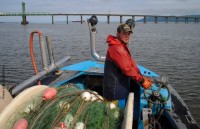Columbia Riverkeeper, local and state agencies, and tribes recently submitted detailed comments to the U.S. Army Corps of Engineers (Corps), and to the Oregon Department of Environmental Quality that describe why Oregon LNG’s project would violate environmental laws. Over two dozen fishing, landowner, community safety, and conservation organizations joined Riverkeeper on these comments:

- Columbia Riverkeeper et al. Public Comments Oregon LNG: Corps
- Columbia Riverkeeper et al. Public Comments Oregon LNG: DEQ
- Expert Report: Review of the Impacts of Oregon LNG's Proposed Pipeline on Aquatic Ecosystems. Jonathan Rhodes, PhD. Planeto Azul Hydrology. January 12, 2015
- Expert Report: Review of the Draft Biological Assessment and Essential Fish Habitat Assessment for Proposed Oregon LNG Terminal Project. Richard Williams, PhD. Clear Creek Consulting. January 8, 2015
- Oregon Department of Fish and Wildlife (ODFW) Public Comments Oregon LNG
- Columbia River Estuary Study Taskforce (CREST) Public Comments Oregon LNG
- Center for Biological Diversity Public Comments Oregon LNG
- State of Oregon Letter to Federal Energy Regulatory Commission (FERC)
FOR IMMEDIATE RELEASE
SCIENCE SHOWS VITAL FISH HABITAT THREATENED BY PROPOSED
OREGON LNG TERMINAL
Experts and Agencies Flag Major Problems in Massive LNG Export Proposal
Feb. 5, 2015 (Portland, OR) – Fisheries experts and agencies are raising serious concerns about how a proposed liquefied natural gas (LNG) terminal at the mouth of the Columbia River would impact endangered salmon and commercial and sport fishing. The Oregon LNG project proposes dredging an area the size of 102 football fields in critical salmon habitat and building a pipeline that would cross over 100 streams and rivers – a combination that is drawing sharp criticism from fisheries experts and agencies weighing in on the first major public comment opportunity for Oregon LNG’s project.

“This project flies in the face of good science and good public policy,” said Columbia Riverkeeper Conservation Director, Dan Serres. “From the stand point of destroying salmon habitat, Oregon LNG’s project is at a scale unlike any other private project in the Lower Columbia River. So it is not surprising that biologists and other scientists looking at this project are raising red flags.”
Columbia Riverkeeper, local and state agencies, and tribes recently submitted detailed comments to the U.S. Army Corps of Engineers (Corps), which is considering issuing permits for the pipeline and terminal. In addition, the Oregon Department of Environmental Quality (DEQ) is collecting public comments until February 16, 2015. Oregon LNG cannot build the terminal and gas pipeline without permits from DEQ and the Corps.
Not only would the project harm salmon habitat, but it also presents a risk to a vibrant local fishing industry. Because the Oregon LNG project could disrupt access for fishers, crabbers and other boaters in the Astoria/Warrenton area, several fishing associations joined comments that urged the Corps to deny the Oregon LNG proposal.
“Putting a massive LNG terminal in the heart of the lower Columbia’s most popular commercial and recreational fishery undermines decades of work to protect fishing opportunities in the lower Columbia River,” said Bob Rees, Columbia River fishing guide and Executive Director of the Association of Northwest Steelheaders. “On top of this, our region has invested billions of dollars in restoring salmon habitat. And a lot of this money is focused in the Columbia River Estuary near Oregon LNG’s project. The contradictions beg for bold action from regulators to protect the Pacific Northwest’s fishing heritage.”
Cheryl Johnson, a Clatsop County resident and retired school librarian, stated, “Our community has spoken loud and clear in opposition to LNG, and we are thrilled to see new evidence from experts that supports our long-standing support for a clean, healthy, LNG-free estuary.”
Key expert agency comments submitted to the Corps:
The Oregon Department of Fish and Wildlife (ODFW) raised concerns for the project to harm fishing, writing, “…the application does not adequately characterize the potential for substantial disruption of this socially and economically important fishery during construction and operation of the marine terminal complex.”
The Columbia River Estuary Study Taskforce (CREST) explained that Oregon LNG undermined ongoing, important restoration efforts in the Estuary, stating, “The proposed project will impact limited and fragmented habitats and ongoing salmon recovery efforts. The entire peninsula has a high potential for restoration, is close to the mouth of the Columbia River, and is hydrologically connected to ongoing restoration work in the Skipanon River, Youngs Bay, and Youngs Bay tributaries.”
Richard N. Williams, a Ph.D. Fisheries expert who reviewed the Oregon LNG proposal, concluded that “…it is clear that construction and operation of the proposed OLNG project would negatively impact ESA-listed salmonids of a variety of species and life stages throughout the entire year.”
ABOUT COLUMBIA RIVERKEEPER
Columbia Riverkeeper’s mission is to protect and restore the water quality of the Columbia River and all life connected to it, from the headwaters to the Pacific Ocean. Representing over 8,000 members and supporters, Columbia Riverkeeper works to restore a Columbia River where people can safely eat the fish they catch, and where children can swim without fear of toxic exposure. The organization is a member of Waterkeeper Alliance, the world’s fastest growing environmental movement, uniting more than 200 Waterkeeper organizations worldwide. For more information go to columbiariverkeeper.org/our-work/lng/.


